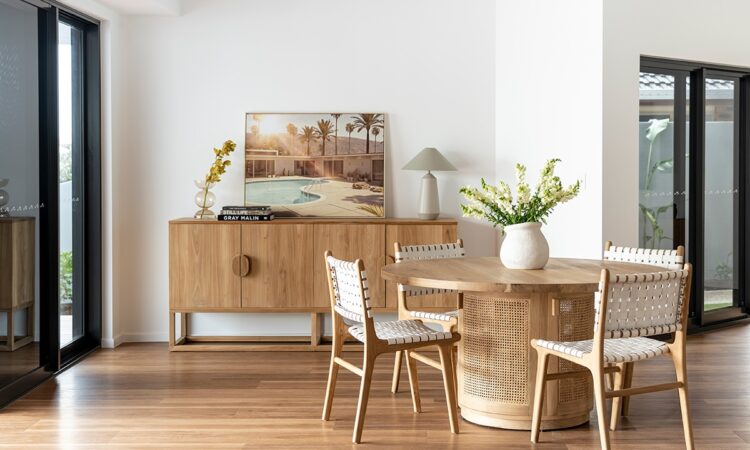
Choosing the perfect dining table for your home is more than just picking out a piece of furniture. It’s about creating a space where memories are made, where family and friends gather, and where meals are shared. A dining table serves as both a functional item and a focal point in your home. But with so many options available, finding the right dining table can feel like a daunting task. Whether you’re furnishing a cozy apartment or a spacious home, there are a few key factors to consider that will help guide your decision and ensure that the table you choose not only fits your space but also complements your style and lifestyle.
Assessing Your Space
Before you start browsing dining tables, it’s important to evaluate the space where the table will go. Measure the area where you plan to place the table to determine how much room you have to work with. Keep in mind that dining tables need space not only for the table itself but also for chairs and the ability to move around comfortably.
A common mistake is choosing a table that’s too large for the room, which can make the space feel cramped and uncomfortable. On the other hand, a table that’s too small for the space can look out of place. As a general rule, ensure that there’s at least 36 inches of clearance around the table for chairs and movement. This gives enough space for people to comfortably sit and get up without feeling cramped.
If you’re working with a smaller dining area, consider a round table. These tables can make better use of limited space because they don’t have sharp corners, which can make it easier to navigate through the room. Additionally, a round table often allows for more flexibility in seating arrangements and creates a more intimate dining experience.
Style and Design
Once you’ve assessed your space and narrowed down the size, it’s time to consider the style and design of the dining table. Your table should complement the overall aesthetic of your home, whether that’s traditional, modern, rustic, or contemporary.
If you lean toward a more classic or traditional style, a solid wood dining table can bring timeless beauty to your space. Look for tables made from hardwoods like oak, walnut, or cherry for a piece that will last for years. For a more modern look, a dining table with sleek lines, glass tops, or metal accents might be a better fit. These tables often create a minimalist and chic vibe, adding an air of sophistication to your dining room.
If you’re interested in blending old and new, consider a transitional style that combines elements from different periods, such as a modern table with antique-inspired legs. These tables are versatile and can fit well in a variety of spaces.
For an even more personal touch, you can explore custom dining tables that are made to fit your exact specifications. Custom pieces allow you to choose the material, color, size, and finish to ensure your table is one-of-a-kind. While the investment may be higher, a custom table can add significant value to your home, both in terms of style and function.
It’s also worth exploring reviews of furniture retailers. For example, these Coleman Furniture reviews from customers share their experiences on the quality, durability, and delivery of dining tables and other furniture. Taking time to read through these reviews can help guide you toward brands that consistently deliver on style and quality.
Shape and Functionality
Another factor to consider when choosing a dining table is the shape. While rectangular and square tables are the most common, there are other shapes to consider depending on the layout of your dining room and your needs.
- Rectangular Tables: These tables are the most versatile and work well in most dining rooms, especially if you need to seat a larger group. They’re ideal for elongated spaces and typically offer the most seating options.
- Round Tables: A round table is perfect for smaller spaces, as they don’t take up as much visual space and allow for easier conversation. They also work well for creating a cozy and intimate dining experience. Round tables are great for four to six people, though larger versions can be made for bigger groups.
- Oval Tables: An oval table is a variation of the rectangular design but with softer edges. These tables are ideal for families who prefer a bit of elegance without the harsh lines of a rectangular table. They’re great for larger families and create a sense of flow in the room.
- Square Tables: These tables are often used for small, square-shaped dining rooms. They can be excellent for seating up to four people, though larger square tables do exist.
Consider how you typically use the dining table—whether for large family meals, casual dining, or entertaining guests. If you regularly host dinners with friends or family, you may want a table with an extendable feature. These tables allow you to adjust the size depending on the number of guests. Many modern tables come with built-in leaves that extend the table’s length, making them an ideal solution for those who host often but don’t want a permanently large table taking up space.
Materials and Durability
The material of your dining table plays a major role in both its durability and aesthetic appeal. Different materials come with distinct benefits, so it’s important to think about both function and longevity.
- Wood: Wood tables are timeless and offer warmth and character to any dining room. Hardwoods like oak, walnut, and maple are durable and can withstand the wear and tear of daily use. Wood tables are also versatile, available in a wide range of finishes from rustic to polished.
- Glass: A glass dining table offers a sleek, modern look and can make a space feel open and airy. While glass tables are typically easy to clean, they can be more prone to scratches and require extra care to maintain their appearance. They’re also not as durable as wood, especially in homes with young children or pets.
- Metal: A metal dining table can be a great choice for those seeking a more industrial or modern aesthetic. Metal is durable, sturdy, and easy to clean, but it may lack the warmth of wood. Some people find metal tables to be too cold or uninviting, but when paired with the right seating, it can make for an edgy and stylish statement piece.
- Stone: Dining tables made from materials like marble or granite are luxurious and durable, though they can be heavy and require special care to avoid stains or scratches.
When choosing a material, think about your lifestyle. If you have small children or pets, you might want to opt for a more durable and low-maintenance option. Wood and metal tables tend to be easier to maintain, while glass and stone may require more frequent cleaning and care.
Choosing the Right Retailer
Once you’ve determined the style, size, and material of your dining table, it’s time to think about where to purchase it. Whether you’re looking for something traditional or a modern design, make sure to purchase from a reputable retailer that offers quality products and excellent customer service. Many retailers offer a wide range of dining tables with varying price points. Before making a purchase, consider reading through retailer reviews and others to ensure you’re getting the best value for your money. Reviews can offer helpful insights into product quality, durability, and the overall buying experience.
Conclusion
Choosing the right dining table for your space requires careful consideration of factors such as size, style, material, and functionality. By taking the time to assess your space and understand your needs, you’ll be able to select a table that enhances the ambiance of your dining area while offering the practicality you need for everyday use. Remember to explore customer feedback on furniture retailers, and focus on durability, style, and comfort when making your decision. With the right dining table, you’ll create a warm, inviting space where loved ones can gather, celebrate, and create lasting memories.




